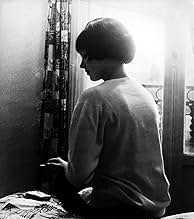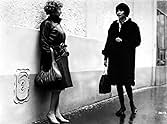IMDb RATING
7.8/10
36K
YOUR RATING
Twelve episodic tales in the life of a Parisian woman and her slow descent into prostitution.Twelve episodic tales in the life of a Parisian woman and her slow descent into prostitution.Twelve episodic tales in the life of a Parisian woman and her slow descent into prostitution.
- Awards
- 3 wins & 1 nomination total
Sady Rebbot
- Raoul
- (as Saddy Rebbot)
André S. Labarthe
- Paul
- (as André Labarthe)
Guylaine Schlumberger
- Yvette
- (as G. Schlumberger)
Peter Kassovitz
- Jeune homme
- (as Peter Kassowitz)
Eric Schlumberger
- Luigi
- (as E. Schlumberger)
Henri Attal
- Arthur
- (as Henri Atal)
Mario Botti
- L'italien
- (uncredited)
Storyline
Did you know
- TriviaThe whole movie script fit on one page, where the sequence of episodes was recorded. The text was not written in advance, and the actors said what was appropriate for the situation.
- GoofsWhen Raoul and Nana meet for the first time, Raoul leaves his notebook on the cafe table by mistake and Nana opens it. The camera changes to read over her shoulder, but the sound of gunshots startles her into closing the notebook. In the next shot, the notebook is nowhere to be seen, neither in her hands nor on the table.
- ConnectionsEdited into Bande-annonce de 'Vivre sa vie: Film en douze tableaux' (1962)
Featured review
The crux of 60's Godard. His quirks are broken down into twelve segments manageable for the inexperienced viewer. If only one Godard film is to be watched, it might be this one. Though none of us would want to live in that world.
The film opens with an entrancing first ten minutes. The credit sequence and ensuing scene introduce the crucial theme of acting versus reality. Nana, played by Anna Karina, seems to never truly escape the personality of the actress who portrays her. Instead of avoiding this, Godard embraces the ambiguity and creates an entire film that obsesses over Karina's image. From the credits to "Fin"? the audience, like Nana, is fixated on her outward appearance. She constantly references her desire to be in movies and have her picture taken. Ultimately, she becomes a prostitute, seemingly the only place to turn for a girl who allows herself to be mercilessly controlled by men. This tragedy is underscored by her clear desire to be "special"? and, most potently, in her tearful viewing of Jeanne d'arc, a woman who faces death at the hands of men. Nana's personality and development can be seen as a vehicle for Godard's philosophy on film. The "men photographing women" had become perverted to the point of solicitation and death. The obvious parallels between the ending of VIVRE and BREATHLESS suggest a pessimistic condemnation of contemporary law and society.
Godard's deliberate camera motion, defiant attitude towards cinematic grammar, and clear pacing created a film that, though fictional, is one of the most honest human portraits available. Always experimenting with sound, the director never succumbs to standard over-the- shoulder dialogue sequences. Instead, he accesses another level of meaning by making deliberate choices over who is seen when saying specific words. Sometimes there are cuts and sometimes there are pans, but never is there a decision that seems arbitrary or purely for the sake of ease. While Godard's films do own a simple and unashamed quality that might lend itself to less expensive filmmaking, it is clear that his choices serve specific purposes and are always a slave to the greater objectives in the film. One of the most striking scenes in VIVRE SA VIE is where Nana is writing a letter. It is a simple act on which most directors would only spend a few seconds. Instead, Godard places a close-up on the letter and allows the audience to watch the entire process and become engulfed in Nana's (or Karina's) beautiful handwriting and the earnest quality of the letter.
VIVRE SA VIE successfully provides a tidy summary of Godard's quirky brilliance. For those willing to explore his genius, this film is the ideal starting place (if not working chronologically). But be careful. Once his capabilities are discovered, they will never leave you.
89.8
The film opens with an entrancing first ten minutes. The credit sequence and ensuing scene introduce the crucial theme of acting versus reality. Nana, played by Anna Karina, seems to never truly escape the personality of the actress who portrays her. Instead of avoiding this, Godard embraces the ambiguity and creates an entire film that obsesses over Karina's image. From the credits to "Fin"? the audience, like Nana, is fixated on her outward appearance. She constantly references her desire to be in movies and have her picture taken. Ultimately, she becomes a prostitute, seemingly the only place to turn for a girl who allows herself to be mercilessly controlled by men. This tragedy is underscored by her clear desire to be "special"? and, most potently, in her tearful viewing of Jeanne d'arc, a woman who faces death at the hands of men. Nana's personality and development can be seen as a vehicle for Godard's philosophy on film. The "men photographing women" had become perverted to the point of solicitation and death. The obvious parallels between the ending of VIVRE and BREATHLESS suggest a pessimistic condemnation of contemporary law and society.
Godard's deliberate camera motion, defiant attitude towards cinematic grammar, and clear pacing created a film that, though fictional, is one of the most honest human portraits available. Always experimenting with sound, the director never succumbs to standard over-the- shoulder dialogue sequences. Instead, he accesses another level of meaning by making deliberate choices over who is seen when saying specific words. Sometimes there are cuts and sometimes there are pans, but never is there a decision that seems arbitrary or purely for the sake of ease. While Godard's films do own a simple and unashamed quality that might lend itself to less expensive filmmaking, it is clear that his choices serve specific purposes and are always a slave to the greater objectives in the film. One of the most striking scenes in VIVRE SA VIE is where Nana is writing a letter. It is a simple act on which most directors would only spend a few seconds. Instead, Godard places a close-up on the letter and allows the audience to watch the entire process and become engulfed in Nana's (or Karina's) beautiful handwriting and the earnest quality of the letter.
VIVRE SA VIE successfully provides a tidy summary of Godard's quirky brilliance. For those willing to explore his genius, this film is the ideal starting place (if not working chronologically). But be careful. Once his capabilities are discovered, they will never leave you.
89.8
- TheFamilyBerzurcher
- Mar 6, 2012
- Permalink
- How long is Vivre sa vie?Powered by Alexa
Details
Box office
- Budget
- $64,000 (estimated)
- Gross US & Canada
- $24,517
- Opening weekend US & Canada
- $8,336
- Jun 1, 2008
- Gross worldwide
- $64,625
- Runtime1 hour 25 minutes
- Color
- Sound mix
- Aspect ratio
- 1.33 : 1
Contribute to this page
Suggest an edit or add missing content














